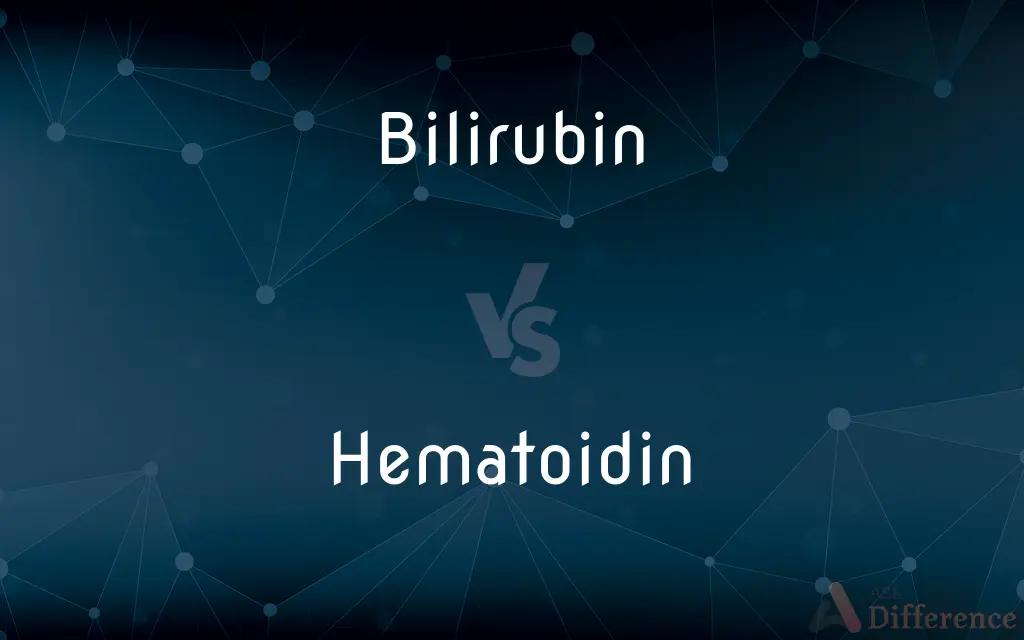Bilirubin vs. Hematoidin — What's the Difference?
By Tayyaba Rehman & Maham Liaqat — Updated on April 17, 2024
Bilirubin is a yellow compound produced by the breakdown of hemoglobin, while hematoidin, chemically similar, appears in bruises and is less water-soluble.

Difference Between Bilirubin and Hematoidin
Table of Contents
ADVERTISEMENT
Key Differences
Bilirubin is a byproduct of the normal breakdown of red blood cells, primarily found in the liver and released into the bile. Whereas hematoidin is a pigment found in old bruises, suggesting localized breakdown and absorption of blood.
Bilirubin levels in the blood can indicate liver function and are monitored in medical settings, especially for jaundice in newborns. On the other hand, hematoidin does not typically have a role in routine medical diagnostics and is more often noted in pathological examinations.
Bilirubin is processed by the liver and is water-soluble once conjugated, which aids in its excretion. Conversely, hematoidin is inherently less water-soluble, remaining in tissues longer and manifesting as yellow-brown crystals microscopically.
In conditions affecting liver function, such as hepatitis or cirrhosis, bilirubin levels can become elevated, leading to jaundice. Whereas, hematoidin accumulation is generally associated with the resolution of a local hematoma and is not related to systemic diseases.
The measurement of bilirubin is crucial for diagnosing and managing several diseases, including liver and biliary disorders. Hematoidin, however, is mainly of interest in histological studies to understand tissue changes following hemorrhages.
ADVERTISEMENT
Comparison Chart
Origin
Breakdown of hemoglobin in the liver
Breakdown of blood in tissues
Solubility
Water-soluble (conjugated form)
Less water-soluble
Medical Relevance
High (used to diagnose liver diseases)
Low (observed in histological exams)
Appearance
Yellow compound
Yellow-brown crystals
Role in Body
Processed and excreted by liver
Remains at sites of old bruises
Compare with Definitions
Bilirubin
Bilirubin testing is routine in hospitals to monitor liver health.
Bilirubin tests are part of standard blood panels during physical examinations.
Hematoidin
A pigment found in old bruises and indicative of blood degradation.
Hematoidin crystals are a common finding in resolving hematomas.
Bilirubin
A yellow pigment formed by the breakdown of hemoglobin during red blood cell recycling.
High levels of bilirubin in the blood can lead to jaundice.
Hematoidin
It forms yellow-brown crystals, visible under a microscope.
Pathologists identify hematoidin during tissue analysis.
Bilirubin
It is processed by the liver, becoming more water-soluble for excretion.
Bilirubin is excreted into bile, which enters the intestine.
Hematoidin
Its presence helps pathologists understand tissue repair processes.
Hematoidin accumulation is studied in cases of extensive bruising.
Bilirubin
Elevated bilirubin levels may indicate liver dysfunction or blockages.
Elevated bilirubin is a common sign of liver disease.
Hematoidin
Not typically used in clinical diagnostics.
Hematoidin is not measured in routine blood tests.
Bilirubin
Newborns often have high bilirubin levels, requiring monitoring.
Newborn jaundice is typically treated with light therapy.
Hematoidin
Unlike bilirubin, it is less soluble and persists in tissue.
Hematoidin can remain in tissues long after a bruise has healed.
Bilirubin
Bilirubin (BR) is a yellow compound that occurs in the normal catabolic pathway that breaks down heme in vertebrates. This catabolism is a necessary process in the body's clearance of waste products that arise from the destruction of aged or abnormal red blood cells.
Hematoidin
(obsolete) bilirubin
Bilirubin
An orange-yellow pigment formed in the liver by the breakdown of haemoglobin and excreted in bile.
Hematoidin
A crystalline or amorphous pigment, free from iron, formed from hematin in old blood stains, and in old hemorrhages in the body. It resembles bilirubin. When present in the corpora lutea it is called hæmolutein.
Bilirubin
A reddish-yellow bile pigment, C33H36N4O6, derived from the degradation of heme.
Hematoidin
An orange-yellow pigment in the bile that forms as a product of hemoglobin; excess amounts in the blood produce the yellow appearance observed in jaundice
Bilirubin
(biochemistry) A bile pigment that is a product of the breakdown of the heme portion of hemoglobin (which occurs within macrophages as they digest red blood cells), and which is responsible for the yellowish color seen in bruises. Extremely high levels of bilirubin may cause jaundice.
Bilirubin
A reddish yellow pigment present in human bile, and in that from carnivorous and herbivorous animals; the normal biliary pigment.
Bilirubin
An orange-yellow pigment in the bile that forms as a product of hemoglobin; excess amounts in the blood produce the yellow appearance observed in jaundice
Common Curiosities
What is hematoidin and where is it found?
Hematoidin is a pigment that appears in tissues at sites of old bruises.
Is hematoidin involved in any disease processes?
Hematoidin itself is not involved in disease processes; it indicates localized blood breakdown.
Can hematoidin levels be measured like bilirubin?
No, hematoidin levels are not typically measured as it is a histological finding.
How is bilirubin excreted from the body?
Bilirubin is excreted from the body in bile, which is processed by the liver and discharged into the intestines.
What does the presence of hematoidin indicate in tissue samples?
It indicates old hemorrhages and the body's natural healing process in tissue samples.
What does elevated bilirubin indicate in adults?
It often indicates liver dysfunction or bile duct obstructions in adults.
What role does the liver play in processing bilirubin?
The liver processes bilirubin to make it water-soluble, facilitating its excretion.
What causes high bilirubin levels in the blood?
High bilirubin levels can be caused by liver diseases, blocked bile ducts, or excessive breakdown of red blood cells.
Why is bilirubin important for newborns?
Monitoring bilirubin in newborns is crucial as high levels can lead to neurological damage if not treated.
What is bilirubin and where is it produced?
Bilirubin is a byproduct of hemoglobin breakdown, produced in the liver.
Is hematoidin a health concern?
Hematoidin itself is not a health concern but a part of the tissue healing process after bruises.
How does hematoidin differ from bilirubin in solubility?
Hematoidin is less water-soluble compared to bilirubin, especially its conjugated form.
Why is bilirubin levels monitoring important in liver disease?
It helps in diagnosing and gauging the severity of liver diseases.
Can hematoidin be found in blood tests?
No, hematoidin is not found in blood tests; it's observed in tissue samples.
What clinical tests are used to measure bilirubin?
Blood tests including total and direct bilirubin levels are commonly used.
Share Your Discovery

Previous Comparison
Device vs. Equipment
Next Comparison
Sorceress vs. WitchAuthor Spotlight
Written by
Tayyaba RehmanTayyaba Rehman is a distinguished writer, currently serving as a primary contributor to askdifference.com. As a researcher in semantics and etymology, Tayyaba's passion for the complexity of languages and their distinctions has found a perfect home on the platform. Tayyaba delves into the intricacies of language, distinguishing between commonly confused words and phrases, thereby providing clarity for readers worldwide.
Co-written by
Maham Liaqat











































